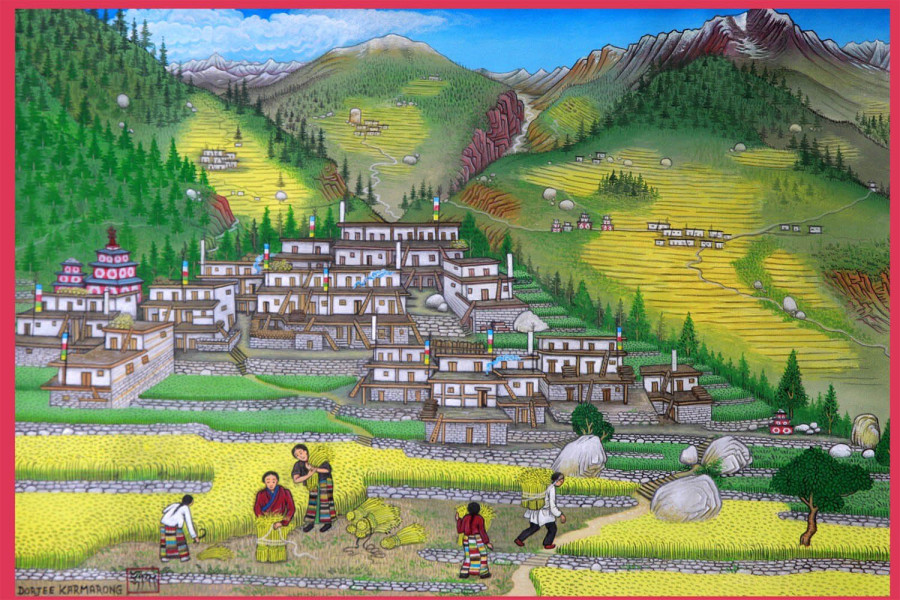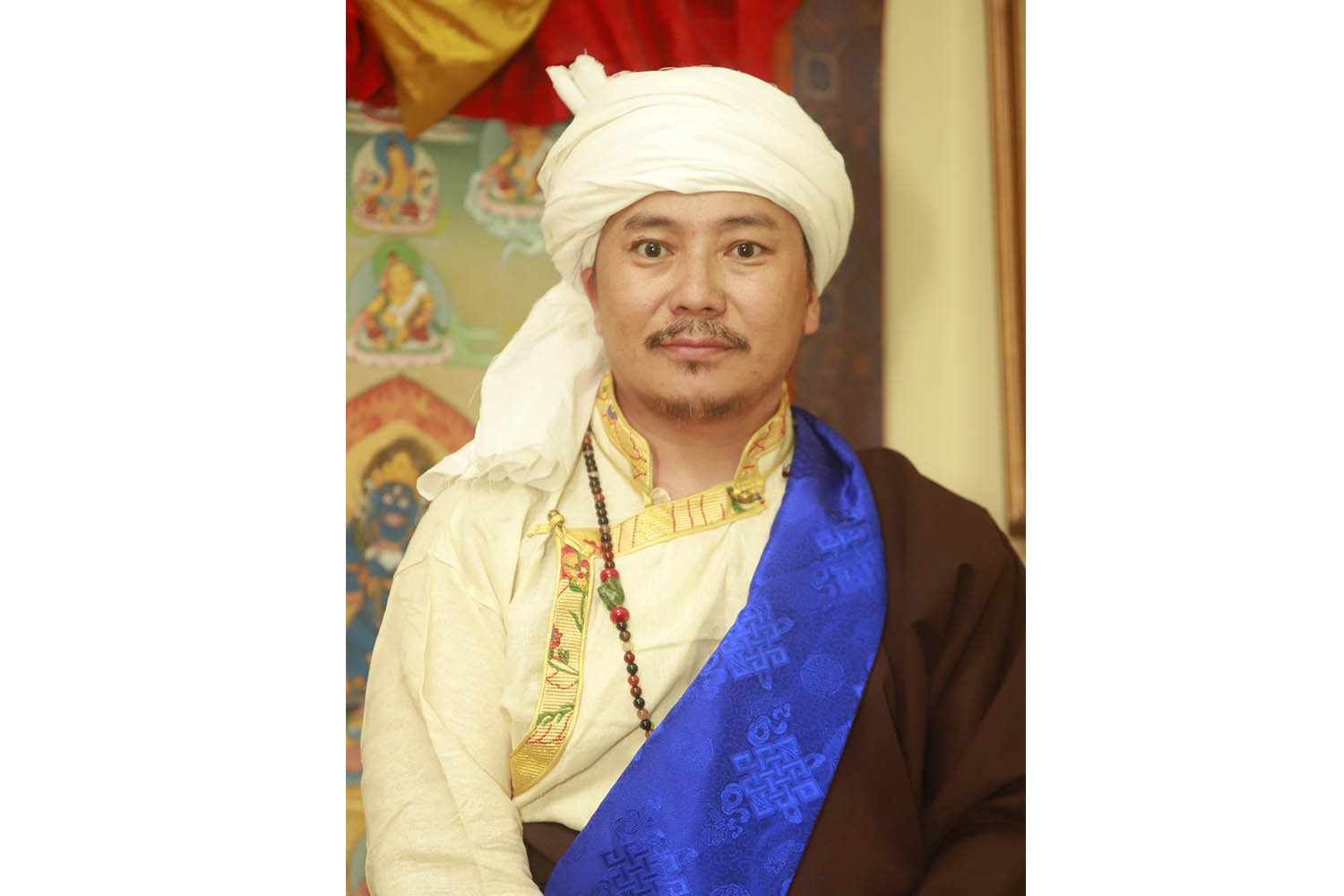Arts
A journey through art and identity
Artist Dorjee Karmarong’s vibrant paintings celebrate the culture and traditions of his community.
Rishika Dhakal
When five-year-old Dorjee Karmarong caught a cold, his family took him to a traditional doctor who was also a Thangka painter. As a playful gesture, the doctor told young Dorjee that he would recover if he promised to become an artist.
Many years later, Karmarong kept that promise. His works are currently on display at the Siddhartha Art Gallery in an exhibition titled ‘Karmarong: Hidden Valley in the Himalayas’, showcasing 27 paintings. These paintings show the culture and lifestyle of Mugum Karmarong Rural Municipality, located in the Mugu district of Karnali Province.
When asked about his motivation to create art, Karmarong explains, “It feels like we, the Karmarong people, lack a distinct identity. Perhaps it's because those who should see us haven’t, or those who should acknowledge us have failed. Even the Nepal government has yet to recognise the Karmarong community.”
He adds, “As the national anthem says, ‘Sayun thunga fulka hami eeutai maala Nepali,’ meaning many flowers in one garland. We are such flowers. Our culture is unique, and we have contributed to Nepal’s heritage. We aspire to enhance Nepal’s beauty through our culture and make it even more remarkable.”
“The purpose behind creating these artworks is to let people know about the Karmarongs,” Karmarong explains. In his book ‘Ways of Seeing’, John Berger emphasises the importance of understanding the historical and cultural context in which a piece of art is created. Rightly so, to truly appreciate Dorjee’s work, one must first understand the culture of the Karmarong people.

The artist has made this possible in two ways. First, he has published a book detailing the geographical and cultural nuances of the Karmarong community. Second, he conveys this through his artwork.
As the saying goes, “a picture speaks louder than words,” Dorjee’s paintings do just that. They poignantly capture everyday scenes and tell stories of the Karmarong people. His art reflects their customs, traditions, and way of life, offering cultural insight.
Having spent his childhood surrounded by lush green landscapes and serene rivers, Karmarong’s artwork is also a testament to his early experiences in nature. His work embodies ecological aesthetics, showcasing the beauty of the natural world.
“Many people overlook the small details in Thangka art. Through this solo exhibition, I’ve aimed to highlight the unrecorded stories of the Karmarong people—their history, culture, and religious practices—by bringing them into the public eye,” he says.
As you enter the gallery, an artwork of a family of three captures your attention. My conversation with Karmarong, especially about the journey that shaped him into the artist he is today, became essential to understanding the significance of this piece.
The painting of the family, dressed in traditional Tibetan attire, shows the mother carrying a doko, with the father and son walking behind her. This scene symbolises Karmarong’s childhood and reflects his parents’ experiences as rural migrant workers. They would trek on foot over the mountains from Koskar, Himachal Pradesh, back to their village in western Nepal.
The following artworks form a series connecting Karmarong to his childhood in the village. Through these pieces, he skillfully presents an autobiographical depiction of his early years, using personal iconography to explore and express his formative experiences.
Another feature of the artwork is the portrayal of yaks. Influenced by the Karmarong people's strong belief in Dharma and Karma, the yaks, depicted carrying goods on their backs, symbolise how these spiritual principles extend beyond humans, even guiding and influencing the lives of animals.
Inspired by his childhood experiences, Karmarong created a piece titled ‘The Yak and His Young Keeper’. This artwork reflects his journey of learning Thangka art during his apprenticeship with Master Palden, where he mastered the geometric principles of Tibetan iconography. As Palden’s student, Dorjee also learned to blend modern styles with traditional Thangka techniques, allowing him to innovate and express himself more freely in his art.

Two of his abstract paintings showcase these traits. The first, titled ‘The Dance of Elements’, incorporates the five elements of nature and features a monstrous face split into orange and black hues. Its pink hand clutches a cigarette-like object coiled by snakes.
When asked about his interpretation of the artwork, Karmarong explained that it reflects nature's duality: its beauty and peril. He emphasised that mismanaging our natural resources can lead to destruction. The depiction of various wild animals and bombs serves as a reminder of the consequences of our actions toward nature. Similarly, his other painting, ‘The Beauty of a Flawed World’, features geometric shapes and upside-down alphabets.
“We often criticise things that aren’t arranged in a proper order. Through this painting, I want to convey that beauty can be found anywhere. Everything doesn’t need to be perfectly aligned; it’s about one’s perspective and how they view the world,” he says.
Similarly, Karmarong intertwines the narratives of Buddhist and Tibetan mythologies by showcasing various monuments in his art. One feature in his paintings is a three-story structure resembling a house known as Kangni, which serves as a recurring motif. Referred to as the ‘Gate of Virtue’, this structure is built on a raised platform two meters off the ground with a mandala ceiling. The walls surrounding the Kangni illustrate the life of Lord Buddha. According to legend, when Rinpoche witnessed his daughter placing a stone in a sacred spot, he encouraged its reverence. Since that moment, people have started bowing to the stone in hopes of receiving blessings.
After watching ‘Shambhala’, I couldn’t help but notice similarities between the film’s imagery and the artist’s artistic creations, particularly in the portrayal of the monastery. Hearing Karmarong narrate myth stories transports the listeners back to their childhood when the days were filled with tales and fables of the past.
The exhibition also highlights the intriguing story of the monasteries' origins. The tale of Valmo Tsering narrates the myth associated with these origins. According to the legend, a she-spirit with long breasts would chase after young animal herders at the foot of a village. In response, a Lama placed two large boulders on her, resulting in her demise. To honour the Lama, the villagers constructed a monastery. Today, remnants of this site, including a stupa and parts of the old monastery, are still visible.
In his artwork, Karmarong employs acrylic on cotton and a vibrant colour palette dominated by the natural hues of blue, green, and brown. The composition features a goreto bato, similar to those found in the village, allowing viewers to experience the art as if gazing at the region’s scenic landscapes. The painting instils a sense of wonder and admiration, inviting viewers to appreciate the lush greenery and natural beauty of Nepal’s often overlooked places.
Moreover, the painting captures the artist’s love for his roots and heritage, showcasing his effort to bring his culture to the forefront.
In this way, for over 20 years, Karmarong has painted Thangkas and exhibited his work in various countries. He also believes that his journey as an artist may be linked to Karma. A lama suggests that he may be the reincarnation of a yogi from Karmarong who struggled to find an artist to assist in constructing a monastery. The yogi had vowed to be reborn as an artist, and Karmarong deeply resonates with this story, believing that he is fulfilling the yogi’s mission in this lifetime.
Therefore, his solo art exhibition is the story of a spiritual and artistic evolution. Each piece represents not only his personal growth as an artist but also the fulfilment of a karmic vow made by a yogi.
Karmarong: Hidden Valley in the Himalayas
Where: Siddhartha Art Gallery, Baber Mahal
When: September 24 to October 21
Time: Sunday to Friday: 11:00 am to 5:00 pm, Saturday 12:00 pm to 5:00 pm
Entry: Free




 9.59°C Kathmandu
9.59°C Kathmandu

%20(1).jpg&w=200&height=120)








